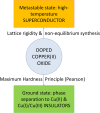High-temperature superconductivity as viewed from the maximum hardness principle
- PMID: 30109441
- PMCID: PMC6097039
- DOI: 10.1007/s00894-018-3777-6
High-temperature superconductivity as viewed from the maximum hardness principle
Abstract
The Maximum Hardness Principle - and its reformulation by Chattaraj as the Minimum Polarizability Principle - is an immensely useful concept which works in support of a chemical intuition. As we show here, it may also be used to rationalize the scarcity of high-temperature superconductors, which stems - inter alia - from rarity of high-density of state metals in Nature. It is suggested that the high-temperature oxocuprate superconductors as well as their iron analogues - are energetically metastable at T ➔ 0 K and p ➔ 0 atm conditions, and their tendency for disproportionation is hindered only by the substantial rigidity of the crystal lattice, while the phase separation and/or superstructure formation is frequently observed in these systems. This hypothesis is corroborated by hybrid density functional theory theoretical calculations for Na- (thus: hole) or La- (thus: electron) doped CaCu(II)O2 precursor. Non-equilibrium synthetic methods are suggested to be necessary for fabrication of high-temperature superconductors of any sort. Graphical abstract Doped oxocuprate superconductors are shown to be unstable with respect to phase separation (disproportionation) in accordance with the Maximum Hardness Principle; their metastability is mostly due to rigidity of [CuO2] sheets and preparation using high-temperature conditions.
Keywords: Band gap; Critical superconducting temperature; Density of states; Hardness; Metal; Superconductor.
Figures



Similar articles
-
The generalized maximum hardness principle revisited and applied to solids (Part 2).Phys Chem Chem Phys. 2017 Nov 29;19(46):30984-31006. doi: 10.1039/c7cp05027e. Phys Chem Chem Phys. 2017. PMID: 29120466
-
A hidden pseudogap under the 'dome' of superconductivity in electron-doped high-temperature superconductors.Nature. 2003 Apr 17;422(6933):698-701. doi: 10.1038/nature01488. Nature. 2003. PMID: 12700755
-
Real and Hypothetical Intermediate-Valence AgII /AgIII and AgII /AgI Fluoride Systems as Potential Superconductors.Angew Chem Int Ed Engl. 2001 Aug 3;40(15):2742-2781. doi: 10.1002/1521-3773(20010803)40:15<2742::AID-ANIE2742>3.0.CO;2-X. Angew Chem Int Ed Engl. 2001. PMID: 29711991 Review.
-
Electronic structure and superconductivity of FeSe-related superconductors.J Phys Condens Matter. 2015 May 13;27(18):183201. doi: 10.1088/0953-8984/27/18/183201. Epub 2015 Apr 16. J Phys Condens Matter. 2015. PMID: 25879999
-
Towards higher-Tc superconductors.Proc Jpn Acad Ser B Phys Biol Sci. 2019;95(7):321-342. doi: 10.2183/pjab.95.024. Proc Jpn Acad Ser B Phys Biol Sci. 2019. PMID: 31406057 Free PMC article. Review.
References
-
- Onnes HK. The resistance of pure mercury at helium temperatures. Commun Phys Lab Univ Leiden. 1911;12:120–120.
-
- Steve N, Nassi M, Bechis M, Ladiè P, Kelley N, Wakefield C. High temperature superconducting cable field demonstration at Detroit Edison. Physica C. 2001;354:49–54. doi: 10.1016/S0921-4534(01)00021-1. - DOI
-
- The value for (Hg0.8Tl0.2)Ba2Ca2Cu3O8.33; the original Tl-free Hg-1223 system with TC of 135 K was discovered first, Schilling A, Cantoni M, Guo JD, Ott HR (1993) Superconductivity above 130 K in the Hg–Ba–Ca–Cu–O system. Nature 363:56–58
LinkOut - more resources
Full Text Sources
Other Literature Sources
Research Materials
Miscellaneous

